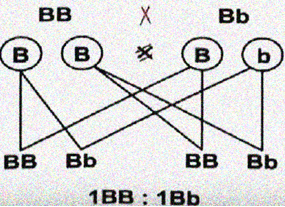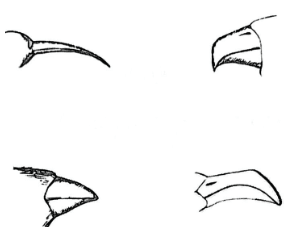Published on February 10th 2024 | 10 mins , 1820 words
KCSE 2023 Biology Paper 1 Marking Scheme
1. Name the disease caused by the following microorganisms
(a) Entamoeba histolytica (1mark)
Amoebic dysentery
(b) Plasmodium Ovale (1mark)
Malaria
2. (a) State two sites in animals where counter current flow of fluids occurs (2 marks)
Kidney tubules/nephrons
Gills of bony fish
Placenta
(c) Explain the significance of the counter current flow system in living organisms
To maintain a steep concentration gradient for efficient and faster exchange of materials
3. The following diagram represents parts of the female reproductive system
(a) Identify the part labelled F (1mk)
F - Vagina
(b) Explain the structural adaptation of the part labelled E to its function (2 marks)
Lined with thick muscles/muscular to allow for expansion for accommodating foetus and to allow for contraction during child birth
(c) Use letter H to label on the diagram the part where ectopic pregnancy is likely to occur
Label should be on Fallopian tube
4. The following diagram represents a skull of a certain mammal.
(a) State the likely mode of nutrition for the animal from which the skull was obtained (1 mark)
Carnivorous
(b) Explain your answer in 4a.
Long pointed, canines for grasping / tearing/ripping flesh
Presence of cusps on molars/premolars for crushing bones
Sharp incisors for nipping/cutting flesh
5. Students observed the smell from a decomposing animal carcass was stronger at the mid-day than early in the morning
(a) Name the physiological process by which the smell reached the students (1mark)
Diffusion
(c) Account for the observation made by the students (2 marks)
Temperatures are higher at midday, which increase the rate of diffusion / movement of air molecules from the decomposing carcass where they are highly concentrated
6. State two ways in which sweating is significant to human body
Thermoregulation / body temperature regulation
Excretion / Elimination of wastes / urea / water
7. State three characteristics of the Kingdom Monera that are not found in the Kingdom Animalia (3 marks)
They are prokaryotic / lack nuclear membrane
They lack membrane-bound organelles
Possess cell walls
They are unicellular
8. The diagram illustrates a set-up to investigate a certain physiological process. The set-up was left undisturbed for 10 mins.
(a) Name the physiological process under investigation
Osmosis
(b) State the observation made after 10 mins
The level of water in the beaker dropped
The visking tubing expanded / swelled more
(c) Account for the observation made in 8(b)
The water in the beaker is hypotonic to the salt solution in the visking tubing, so water moved across the semipermeable membrane into the visking making to swell hence reducing the level of water in the beaker
9. In a genetics study, a pure breeding black bull was crossed with a pure breeding white heifer. All the offsprings were black.
(a) Account for the black colour phenotype in all the offsprings
The gene for black colour coat was dominant over the gene for white colour coat
(b) Work out the genotypic ratio of the offsprings if the pure breeding black bull was crossed with a female heterogeneous for colour (5 marks)
10. Account for the following observations;
(a) When the pancreatic duct of a mammal is blocked, blood sugar regulation remains normal while digestion is impaired (2 marks)
The pancreas secretes both the insulin and pancreatic juice. Insulin is used in blood sugar regulation, while pancreatic juice contains digestive enzymes.
Insulin diffuses directly into the blood circulation, regulating sugar levels. Hence, blood sugar regulation is not affected by the blockage of the pancreatic duct, but digestion is impaired because the pancreatic juice must pass through the pancreatic duct to reach the duodenum
(b) Most desert animals have longer loops of henle (3 marks)
The longer Loop of Henle maximizes the concentration gradient within the kidney, enabling greater water reabsorption.
11. The following diagrams represent beaks of different birds
(a) State the type of evolution illustrated by the diagrams
Divergent evolution
(b) Explain the significance of the type of evolution stated in 11(a) above
The different beaks of the birds enables them to exploit different ecological niches, thus reduces competition for food
12. The following equation represents a certain metabolic reaction taking place in animal cells
(a) Name the organelle where the reaction occurs
Mitochondrion
(b) (i) Calculate the respiratory quotient of the substrate being oxidized
(ii) Identify the substrate being oxidized in the reaction
Fats/Lipids/Oils
(c) State two factors other than oxygen concentration that that affect the rate of the illustrated reaction
Optimum temperature for enzyme action
Substrate concentration
Favourable pH
Age/Activity of the organism
13. The following diagram illustrates a neurone
(a)(i) Identify the neurone
Relay neurone
(ii) Give a reason for your answer in 13 (a)(i)
Lacks myelin sheath
Lacks Schwann cell
(b) (i) Name the part labelled P on the diagram
Dendrites
(ii) State the function of the part named in 13(b)(i)
Transmit impulses to the next motor neurone
14. In an experiment, students added some water to a beaker containing maize flour and yeast. The beaker was covered and left on the laboratory bench undisturbed for three days
(a) State the aim of the experiment
To demonstrate anaerobic respiration/ fermentation
(b) State two observations made by the students after three days
The beaker content had increased temperature
Frothing/swelling of the contents in the beaker
Alcoholic smell
15. (a) State two characteristics observed in a 25-year-old male incapable of producing testosterone home
Shallow voice
Less hair growth in pubic regions and facial hair
Less hairy chest/chin/armpits/body
Less muscular
Small testes
Failure to produce sperm
(b) Name one part in plants where auxins are produced
Apical buds /shoot apex/apical meristem
Shoot tips
Root tips
16. (a) Name the branch of biology that deals with the study of insects
Entomology
(b)Name one piece of apparatus that one would use to collect insects for study
- Pooter
- Sweep net
- Specimen bottle
- Pitfall trap
- Bait trap
17 (a) Distinguish between resolution and magnification as used in microscopy
Magnification – ability of a microscope to enlarge a smaller object to a desired size for clarity/ease of study
Resolution – refers to the ability to distinguish between finer details
(b) State the significance of the following procedures during the preparation of wet mounts of plants tissues:
(i) Staining (1 mark)
Enhances clarity of object / specimen details
(ii) Making thin sections (1 mark)
Reducing the layers of cells to make it transparent in order to allow maximum penetration of light
18 (a) State two means through which plants eliminate excess water (2 marks)
Transpiration
Guttation
(b)Explain the significance of hair on the human skin during cold weather (3 marks)
19. The following diagram represents a stage in the mitotic division of a cell
(a)(i)Identify the stage of mitosis illustrated
Anaphase
(ii)Give a reason for your answer in 19(a)(i)
Chromatids are moving towards the poles
Chromatids have separated
(b)The role of the centrioles in cell division (1 mark)
Formation of spindle fibres
20. State the significance of each of the following characteristics of living things
(a) Irritability
To escape danger and adjust to harsh environmental conditions
Enables organism to seek favourable conditions
Enables organism to escape unfavourable conditions in order to survive
(b) Reproduction
For procreation/to prevent extinction of organisms
Guarantees continuity of species / transmission perpetuation of desirable qualities or traits to the subsequent generation or offspring
21. The following diagram represents a mammalian tooth
(a) Explain the structural adaptation of the tooth to its function (2 marks)
Has cusps to facilitate crushing of food
Has flat/broad surface to provide an area for grinding of food
(b) How does drinking cold water immediately after a meal affect digestion?
Cold water lowers the temperature of the gut, inactivating enzymes which slows digestion
22. Explain the concept of natural selection among organisms in relation to an ecosystem with insufficient food (2 marks)
There will be competition for food
The unfit individuals will lack food, get eliminated through death
The fit individual with characteristics that favour competition will consume the available food and survive to maturity to reproduce fit individuals
Alternative long comprehensive Answer
In an ecosystem with insufficient food, natural selection plays a pivotal role in determining which organisms are best adapted to survive and reproduce. This process unfolds as follows:
- Competition for Food: Limited food resources lead to intense competition among individuals within the ecosystem.
- Elimination of Unfit Individuals: Individuals that are less well-adapted or lack advantageous traits for obtaining food are at a disadvantage. They may struggle to secure enough sustenance and are more likely to perish due to starvation or weakened health.
- Survival of the Fittest: Organisms with traits that confer an advantage in acquiring food, such as efficient foraging abilities or specialized feeding adaptations, are more likely to thrive. These fit individuals outcompete their less adapted counterparts, ensuring their survival and reaching maturity.
- Reproduction of Fit Individuals: Fit individuals that successfully obtain and utilize available food resources have the opportunity to mature and reproduce. Through reproduction, they pass on their advantageous traits to the next generation, thereby perpetuating the cycle of natural selection.
23. The diagram represents a light microscope
(a) Name the part labelled N (1mk)
Mirror
(b) State the functions of the parts labelled L and M
L: Course adjustment Knob
Moves the body tube for rough focusing or positioning of the specimen
M: Condenser
Concentrates light on the stage or object or specimen










